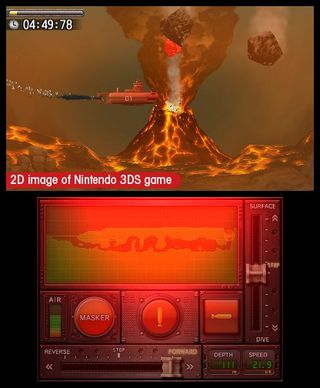GamesRadar+ Verdict
Pros
- +
Experimental controls mostly pay off
- +
Blasting the occasional boss with missiles
- +
It's unique among the starting 3DS line-up
Cons
- -
Periscope Strike gets old fast
- -
Hardly made with the 3DS in mind
- -
Not enough content to justify price
Why you can trust GamesRadar+
Reviewing launch games is a strange situation. You%26rsquo;re playing one of the first games on a new system, so a standard hasn%26rsquo;t really been set yet on just what the new hardware can do. Plus the assortment of launch games can be so small that a game no one would care about six months from now could be considered a success. Regardless, if you%26rsquo;re going to test the waters of a new piece of tech, you could do worse than the rather experimental submarine exploration gameSteel Diver, but it shouldn%26rsquo;t be the first title you buy.
First shown to gamers years ago as a DS demo, Steel Diver has been reworked for 3DS. The story is practically non-existent: You control subs that plumb the depths in search of enemy ships to destroy. You%26rsquo;re given three different subs to choose from on each mission - the small but dexterous Manatee, the more powerful but unwieldy Serpent, and the midsize, all-around sub Blue Shark. There%26rsquo;s no more personality than that, aside from unlockable decals to put on the ships.
Predictably, Steel Diver is at its best when you take a sub underwater, even if its unconventional control scheme takes some getting used to. Instead of using the system%26rsquo;s nice, new analog stick, virtually everything happens on the touchscreen. You adjust the sub%26rsquo;s speed, direction, and whether it dives or surfaces using one of two sliders on the lower display. You initially yearn for direct control, and it%26rsquo;s frustrating when the sub just won%26rsquo;t do what you want fast enough, but we warmed to the novel approach after the first couple missions.

Once we stopped treating it like the game we thought it would be and gave in to the deliberate, at times glacial pace, we began to enjoy planning when and how to move our sub in anticipation of what the map had in store. You%26rsquo;re continually switching your view from top to bottom screen, adjusting for what the SONAR says and what enemies or obstacles you can only see in front of the ship. Unfortunately, that can get to be a real tough proposition in situations where you have to move up a steep incline, avoid falling rocks and then elude missiles from a hostile sub.
The combat was more annoying than the at times touchy undersea traversal. You have unlimited missiles to fire, but they take time to reload, and if you were off in your first shot, making small adjustments in the angle of your boat and firing again can be trying. Several times we just ran from the stationary adversaries instead of fighting them, and the biggest irritation was facing enemies on the surface. Usually those much bigger boats rained down harsher attacks, and if you weren%26rsquo;t in the tiny Manatee, angling your attacks while simultaneously hearing the klaxon sound-off when hit wasn%26rsquo;t particularly fun.

When you get down to it, Steel Diver is a racing game in a lot of ways, just a really slow one. The constant push to get your sub to the end of the map is entertaining and keeps your eyes glued to the screen. But once you%26rsquo;ve at last barreled through all the maps, SD%26rsquo;s biggest failing is clear: a shortage of content.
The Campaign mode starts you with five maps, each of which will take between 10 and 30 minutes to complete. If you can beat those five with all three sub types, you unlock two more maps, and if you beat those you unlock tougher versions of the previous areas. Having only seven maps is a real letdown, and the subs aren%26rsquo;t diverse enough to make that many multiple playthroughs particularly worthwhile.

Another failing is that the standard gameplay is on a two dimensional plane, seemingly defeating the whole gimmick of the system. Granted there%26rsquo;s occasionally stuff in the background that might look more interesting with the 3D turned up, but it%26rsquo;s easy to tell this game was first designed for the DS. We ended up playing the majority of it in 2D.
The 3D does come into play in Periscope Strike mode, which appears after each map%26rsquo;s completion and is its own separate feature. In Periscope Strike the sub stands still, you just rotate the view to spot enemy ships and blast torpedoes at them. Not only does it use the 3D, but the mode also takes advantage of the built-in motion controls, making you physically turn the system to change the periscope%26rsquo;s view. It was a cute aside, but it%26rsquo;s an arcade-style throwaway in the grand scheme of things, as was the two player, turn-based experience Steel Command.

Ultimately that%26rsquo;s the biggest problem with Steel Diver: there%26rsquo;s just not enough to do, at least not for the price. We appreciate that Nintendo did something different here, and a system%26rsquo;s launch is a great time to be more experimental, but if we%26rsquo;re going to pay $39.99 for a new 3DS game, we%26rsquo;re going to need more than this. If the price was slashed, or if you%26rsquo;re bored of the bigger and better 3DS starters, you could do worse than Steel Diver, but it%26rsquo;s far from a killer app.
Mar 23, 2011
More info
| Genre | Adventure |
| Description | plan your attacks in the stategy based first person submarine shooter. |
| Platform | "3DS" |
| US censor rating | "Everyone 10+" |
| UK censor rating | "" |
| Release date | 1 January 1970 (US), 1 January 1970 (UK) |
Henry Gilbert is a former GamesRadar+ Editor, having spent seven years at the site helping to navigate our readers through the PS3 and Xbox 360 generation. Henry is now following another passion of his besides video games, working as the producer and podcast cohost of the popular Talking Simpsons and What a Cartoon podcasts.

Former Helldivers 2 lead writer praises the shooter's community for uniting against the PSN mandate: "We trained them to fight together. And then they fought together"

26 years later, an April Fool's joke turned urban legend comes to life as a Resident Evil 2 mod that lets you Shoryuken zombies as a Street Fighter character

Game of Thrones star Ralph Ineson joins Marvel's Fantastic Four as big bad Galactus

